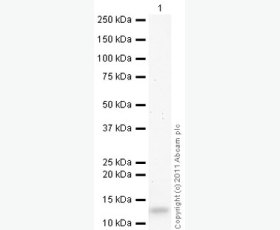Recombinant Human 15-PGDH/HPGD
| Product name: | Recombinant Human 15-PGDH/HPGD |
| Source: | Human Cells |
| Purity: | Greater than 95% as determined by reducing SDS-PAGE. |
| Buffer Formulation: | Supplied as a 0.2 μm filtered solution of 20mM HEPES,150mM NaCl,pH7.4. |
| Applications: | Applications:SDS-PAGE; WB; ELISA; IP. |
| Storage: | Avoid repeated freeze/thaw cycles. Store at 2-8 oC for one month. Aliquot and store at -80 oC for 12 months. |
| UOM: | 100ug/50ug/200ug/1mg/1g |
| Source | Human Cells |
| Description | Recombinant Human HPGD is produced by our Mammalian expression system and the target gene encoding Met1-Gln266 is expressed with a 6His tag at the C-terminus. |
| Names | 15-Hydroxyprostaglandin Dehydrogenase [NAD(+)], 15-PGDH, Prostaglandin Dehydrogenase 1, HPGD, PGDH1 |
| Accession # | P15428 |
| Formulation | Supplied as a 0.2 μm filtered solution of 20mM HEPES,150mM NaCl,pH7.4. |
| Shipping |
The product is shipped on dry ice/ice packs. |
| Storage |
Store at < -20°C, stable for 6 months after receipt. Please minimize freeze-thaw cycles. |
| Purity |
Greater than 95% as determined by reducing SDS-PAGE. |
| Endotoxin | Less than 0.1 ng/µg (1 IEU/µg) as determined by LAL test. |
| Amino Acid Sequence |
MHVNGKVALVTGAAQGIGRAFAEALLLKGAKVALVDWNLEAGVQCKAALDEQFEPQKTLFIQCDV ADQQQLRDTFRKVVDHFGRLDILVNNAGVNNEKNWEKTLQINLVSVISGTYLGLDYMSKQNGGEG GIIINMSSLAGLMPVAQQPVYCASKHGIVGFTRSAALAANLMNSGVRLNAICPGFVNTAILESIE KEENMGQYIEYKDHIKDMIKYYGILDPPLIANGLITLIEDDALNGAIMKITTSKGIHFQDYDTTP FQAKTQVDHHHHHH
|
| Background | 15-hydroxyprostaglandin dehydrogenase [NAD(+)], also known as Prostaglandin dehydrogenase 1, 15-PGDH, HPGD and PGDH1, belongs to the short-chain dehydrogenases/reductases (SDR) family. HPGD localizes to the cytoplasm and can be found in colon epithelium, existing as a homodimer. HPGD catalyzes the NAD-dependent dehydrogenation of lipoxin A4 to form 15-oxo-lipoxin A4. HPGD is down-regulated by cortisol, dexamethasone and betamethasone, up-regulated by TGFB1. HPGD inhibits in vivo proliferation of colon cancer cells. HPGD is the key enzyme for the inactivation of prostaglandins, and thus regulates processes such as inflammation or proliferation. |














